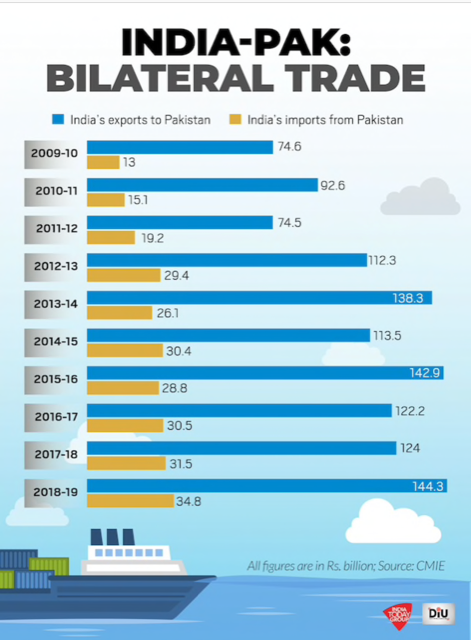On Monday August 5, India repealed Article 370, an article that gave limited autonomy to Indian controlled Kashmir. Pakistan’s response, aside from resolutions and slogans, was to downgrade bilateral ties and suspend bilateral trade. This would mean a lot if India-Pakistan bilateral trade amounted to much, the reality is different.
As per the graphic below in the last ten years trade between the two countries has primarily comprised Indian exports to Pakistan with minimal Pakistani exports to India. From around INR 88 billion in 2009 they have gone up to INR 178 billion in 2019.

Trade between India and Pakistan has never taken off because Pakistan has for decades linked trade to resolving the Kashmir dispute. The South Asian region is the least integrated of all regions in the world with intra-regional trade being around 3% compared to 25% in ASEAN (Association for South East Asian Nations) and 50% in North America under NAFTA (North American Free Trade Agreement).
As per World Trade Organization (WTO) norms, in 1996 India granted Pakistan MFN (Most Favored Nation) status as it gave to all its neighbors, but Pakistan was never able to reciprocate as in the eyes of the Pakistani security establishment economic (and cultural and people to people) ties would hurt their cause (of India being the permanent enemy).
The last two governments – under PPP and PML-N – tried to give India MFN under the name NDMA (Non-Discriminatory Market Access) but the military viewed that as a red line that could not be crossed. After the February 2019 Pulwama terror attacks India withdrew MFN status and hiked import duties.
If India and Pakistan traded like India and China – where the bilateral trade stands at around USD 85-90 billion annually – then suspension of trade would count for a lot.
As of now, the suspension of almost non-existent trade may make good rhetoric but will not make any difference on the ground.
![]()





